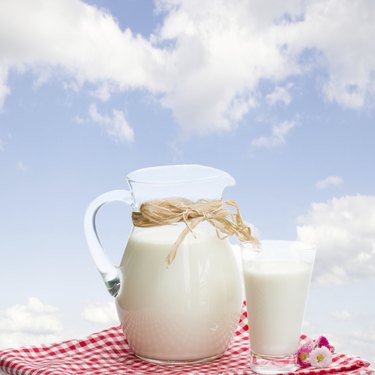
You probably already know that drinking milk adds protein and calcium to your daily diet, but skim milk, in particular, might be the best choice if you have high cholesterol or are looking for ways to keep your cholesterol in the healthy range. In addition to being rich in certain nutrients, skim milk is also fat-free, which contributes to it's benefits in terms of cholesterol.
Skim Milk and Cholestrol
Video of the Day
A 1-cup serving of skim milk contains 5 milligrams of cholesterol. That's less than 2 percent of the 300 milligrams of cholesterol healthy adults should limit themselves to each day, according to the American Heart Association. For comparison, a cup of whole milk has 24 milligrams of cholesterol, which is 8 percent of your daily limit.
Video of the Day
Why Saturated Fat Is Bad
Skim milk is a better choice than whole milk in terms of saturated fat, as well. A cup of skim milk contains no saturated fat while a cup of whole milk has about 4.5 grams. This matters when it comes to cholesterol because eating too much saturated fat can raise your cholesterol levels, according to the American Heart Association. High cholesterol levels increase your risk of heart disease, notes the Centers for Disease Control and Prevention. The opposite is also true. Reducing saturated fat intake can help lower your cholesterol levels, and choosing skim milk over whole milk is one way to accomplish that goal.
Swapping For Skim Milk To Lower Cholesterol
Research backs up the idea that opting for skim milk over whole milk is a good idea for your overall health, including your cholesterol level. A 2010 article published in "Food and Nutrition Research" reports that replacing high fat dairy products, including milk, with lower-fat dairy foods can lower cholesterol levels. The key here is replacement, however. Simply drinking skim milk alone isn't guaranteed to lower your cholesterol level, but reducing your saturated fat intake by switching from whole milk is more likely to help. The calcium in milk might also be useful in reducing the risk of cardiovascular disease and stroke, according to Stuart Patton, author of "Milk: Its Remarkable Contribution to Human Health and Well-Being." Skim milk has slightly more calcium per serving than whole milk.
Making the Change
Whole milk and skim milk have a texture difference. Whole milk is thicker and creamier and has a more pronounced taste. Switching to skim milk can be a bit of shock because it's thinner and has a more mild taste. Start by swapping your whole milk for 2 percent milk. Wait a week or two and then switch from 2 percent to 1 percent milk. Wait a bit longer and then switch to skim milk. This gradual change can help you adjust to the differences more easily. Even opting for 2 percent or 1 percent over whole milk, however, can help cut your saturated fat intake.
- U.S. Department of Agriculture: Milk, Nonfat, Fluid, With Added Vitamin A and Vitamin D (Fat Free or Skim)
- U.S. Department of Agriculture: Milk, Whole, 3.25% Milkfat, With Added Vitamin D
- Centers for Disease Control and Prevention: Cholesterol
- American Heart Association: Knowing Your Fats
- Food and Nutrition Research: Dairy Products and Plasma Cholesterol Levels
- Milk: Its Remarkable Contribution to Human Health and Well-Being; Stuart Patton